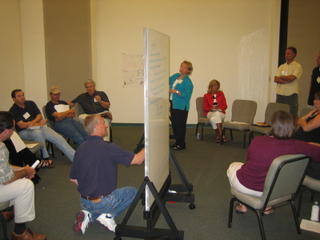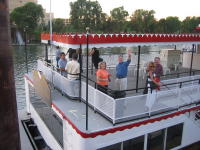Lessons from the Leadership Community
 The second gathering of the third leadership community for externally focused churches finished up at noon today. Very powerful learning experience. Don Simmons was absolutely on the mark. Yesterday he outlined the essential components for volunteer engagement in the acrostic TAFERR.
The second gathering of the third leadership community for externally focused churches finished up at noon today. Very powerful learning experience. Don Simmons was absolutely on the mark. Yesterday he outlined the essential components for volunteer engagement in the acrostic TAFERR.Training—Just in time and just in place. If it’s important…train for it
Affirmation—for who they are… not for what they do. Don’t affirm for their “success” but for their presence…heck, they just showed up!
Feedback—letting people know how they are doing. “Can I offer you some feedback?” Three types of feedback
Compliments—like blowing bubbles…. “Nice job”
Critique—like throwing a baseball at someone’s head…almost always hurts and leaves a bruise
Critique—like tossing a Nerf ball…. “The next time you can….”
Volunteers are worth $37.84 / hour.
Evaluate the process—did the process work? If you take evaluations you must let people know what you are doing with it or they will stop filling them out
Honor for performance—“I noticed you did… Honor people in the way they want to be honored, not what is convenient.
Reflection—So what? / Now what? Did I make any difference? Every volunteer wants to impact some change. People quit when they feel that nobody noticed and they made no difference. Reflective question could include:
What difference do you think you made today? Don asked a non-believer in a blood drive what difference he made and the man answered, “I just saved somebody’s life.” Don linked that exchange to the redemptive power of the gospel.
What Scriptures resonate with your experience today? Can you think of a similar experience where Jesus did something similar?
What images come to your mind?
“There are burning bushes where you can see God but most people just pick the blackberries.”—Don Simmons
“I had the experience but missed the meaning.” Attributed to both TS Elliott and CS Lewis
As people reflect that start with what is seen and physical—“I learned to use a band saw” but move to spiritual and invisible.
We need to keep connecting gospel to service or people will just serve with Kiwanas.
Always answer “why” people are doing this. “My service connects to a greater purpose.” Don told the story of a woman who was snapping bushels of green beans for a missions fair but was visualizing her beans nourishing future missionaries. Two years later a couple returned to the church from Kabul, Afghanistan that were called into missions at the missions fair. The woman was able to say, “My beans did this.” We have to learn to make the connections.
One of the insights he brought to the group was the need for reflection after a serving opportunity. Don cited a study done with two groups of college students that served in an orphanage overseas. One group from Vanderbilt University had a time of reflection after the trip and the group from Occidental College was explicitly asked not to talk about the trip at all. The Vanderbilt group returned the next year and had invited many of their friends. No one from Occidental College showed up.
So what? Did I make a difference?
Now what? Would I do this again and will I make it part of my life?
This was a great insight for all of us. I found myself thinking, “Service with reflection makes the service ten times more valuable than service alone. Service without reflection diminishes service by ten. Therefore service with reflection is a hundred fold more reflective than service alone.”
Peter Morin of Faith Lutheran Golden did the devotion this morning and after a bit of Lectio Divina he shared a diagram in the form of a “Figure 8” and talked about “the journey inward” and “the journey outward.” It is a powerful concept that presents the growth / discipleship model not as a destination (ala 101, 201, 301, etc) but rather a journey. “You can start at any place because the journey inward leads outward and the journey outward leads inward.”
Our discussion yesterday afternoon was about volunteers and laborers for the harvest (Matthew 9). How do we move volunteers to become laborers? One group came up with a helpful model in the form of an hourglass—with the upper glass representing people coming into the church as volunteers but through an intentional process, being transformed into laborers in the bottom glass and then deployed into the community. Hope Church from Oakdale MN, turned the diagram on its side and came up with a model built around “Cast, Catch and Release.” It was all pretty cool.
Our host church set up a Twilight river boat cruise on the Sacramento River--really relaxing.  Afterwards we went to dinner at California Fats in Old Town Sacramento. We finished up this morning with six month “Action Learning Plans” and then I took off for the airport hoping to catch the 2:05 flight to Denver since I have to leave for Mexico at 6 tomorrow morning but no such luck. The plane was full! Rats! I don't get out til after 5pm! But I just discovered for $6.95 I can get a day of Internet service. Life is good.
Afterwards we went to dinner at California Fats in Old Town Sacramento. We finished up this morning with six month “Action Learning Plans” and then I took off for the airport hoping to catch the 2:05 flight to Denver since I have to leave for Mexico at 6 tomorrow morning but no such luck. The plane was full! Rats! I don't get out til after 5pm! But I just discovered for $6.95 I can get a day of Internet service. Life is good.


0 Comments:
Post a Comment
<< Home